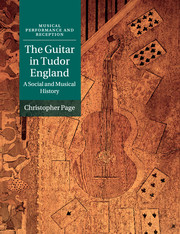Book contents
- Frontmatter
- Dedication
- Contents
- List of figures
- List of tables
- List of music examples
- Acknowledgments
- Note on music examples
- List of abbreviations
- Introduction
- 1 Imagery
- 2 Who owned a gittern?
- 3 The gittern trade
- 4 ‘An instruction to the Gitterne’
- 5 Sounding strings
- 6 The gittern and Tudor song
- 7 Thomas Whythorne: the autobiography of a Tudor guitarist
- Conclusion
- Appendix A The terms ‘gittern’ and ‘cittern’
- Appendix B References to gitterns from 1542 to 1605
- Appendix C The probate inventory of Dennys Bucke (1584)
- Appendix D Octave strings on the fourth and third course
- Appendix E The fiddle tunings of Jerome of Moravia, swept strings and the guitar
- Appendix F The mandore and the wire-strung gittern
- Appendix G The ethos of the guitar in sixteenth-century France
- Appendix H Raphe Bowle
- Bibliography
- Index
7 - Thomas Whythorne: the autobiography of a Tudor guitarist
Published online by Cambridge University Press: 05 June 2016
- Frontmatter
- Dedication
- Contents
- List of figures
- List of tables
- List of music examples
- Acknowledgments
- Note on music examples
- List of abbreviations
- Introduction
- 1 Imagery
- 2 Who owned a gittern?
- 3 The gittern trade
- 4 ‘An instruction to the Gitterne’
- 5 Sounding strings
- 6 The gittern and Tudor song
- 7 Thomas Whythorne: the autobiography of a Tudor guitarist
- Conclusion
- Appendix A The terms ‘gittern’ and ‘cittern’
- Appendix B References to gitterns from 1542 to 1605
- Appendix C The probate inventory of Dennys Bucke (1584)
- Appendix D Octave strings on the fourth and third course
- Appendix E The fiddle tunings of Jerome of Moravia, swept strings and the guitar
- Appendix F The mandore and the wire-strung gittern
- Appendix G The ethos of the guitar in sixteenth-century France
- Appendix H Raphe Bowle
- Bibliography
- Index
Summary
If you wold haue your sonne, softe, womannish, vncleane … set him to dauncing school, and to learn musicke, and than shall you not faile of your purpose.
Philip Stubbes, The Anatomie of Abuses (1583)Thomas Whythorne, a keen player of the gittern during his youth, and sometime pupil in a dancing school, commissioned a portrait of himself in 1569 (Figure 24). By the standards of the day, it shows him at an age when ‘youth's proud livery’ was considered worn, for he was then about forty, but the picture proves that Whythorne wishes to be seen, even to be studied. He does not share the picture with anything except his coat of arms; there is no instrument to proclaim his profession as a household teacher of music, and no prayer book or motto to inspire pious meditation. With the exception of the ‘official’ black that he wears, partly to set off his expensive pendant, Whythorne has dispensed with many conventions of portraiture favoured by the merchants, physicians, lawyers and clergy of his time. Yet the picture may not address the viewer as directly as one might suppose, for the coat of arms which appears there cannot be traced in Tudor Visitations of Somerset whence Whythorne's family came. He had read in Gerard Legh's The Accedens of Armory that arms could be conceded to those of ‘clean life’, loyal to their word and knowledgeable in one or all of the liberal arts; perhaps he simply assumed this heraldry, thinking well of himself in general and of his musical talents in particular.
It would be characteristic of Whythorne to have done so, for he contrived means to emblazon and fictionalise himself in portraiture, print and text throughout his life. His literary effort in this vein was A book of songs and sonets, a substantial collection of his song verse connected by an extensive autobiographical narrative which constantly outgrows the stated purpose of relating the poems to the circumstances that inspired them. The work has elements of a courtesy book, a romance, a collection of aphorisms in the manner of his teacher John Heywood, a tract on the ages of man and a warning about the wiles of women (an admonitory commonplace of contemporary lyric verse).
- Type
- Chapter
- Information
- The Guitar in Tudor EnglandA Social and Musical History, pp. 150 - 165Publisher: Cambridge University PressPrint publication year: 2015



